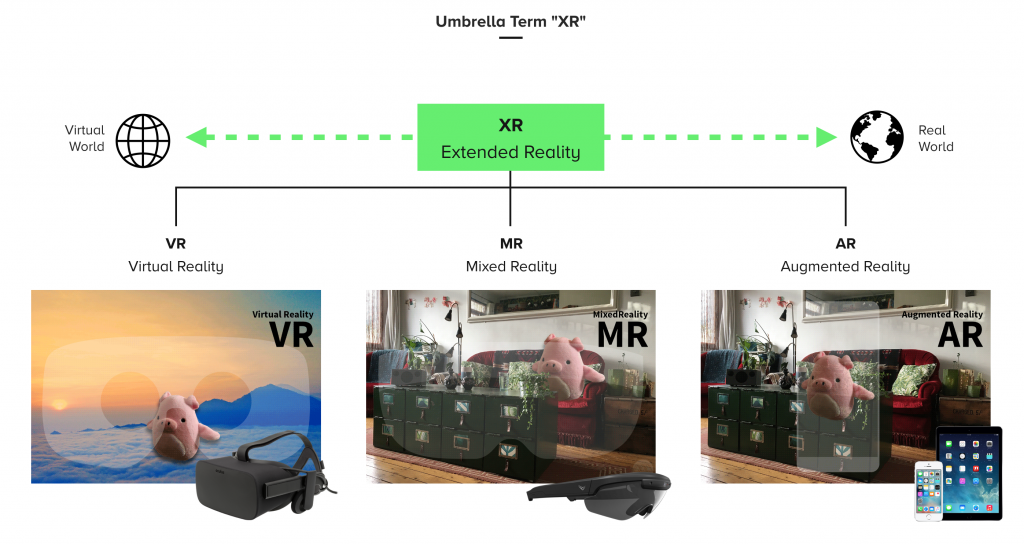Extended Reality (XR) is an umbrella term given to all computer-generated environments that either merge the physical and virtual worlds or create an entirely immersive experience for the user. XR covers three distinct categories: Virtual Reality (VR), Augmented Reality (AR) and Mixed Reality (MR).

Virtual Reality (VR)
Virtual Reality is the use of computer technology to create a simulated environment. Unlike traditional user interfaces, VR places the user inside an experience. Instead of viewing a screen in front of them, users are immersed and able to interact with 3D worlds.
Equipment needed: VR Glasses are mandatory to experience virtual reality. E.g. Oculus Quest, Oculus Rift, HTC Vive, Valve Index.
Advantages: VR is the most technologically mature from all 3. The quality you can achieve is stunning.
Disadvantages: Very few people own their own devices so the market of consumers is not there yet. Now VR is mostly used for B2B purposes and gaming.
If you would like to start with VR I would recommend buying Oculus Quest. It’s a great stand-alone device, and you don’t need a computer for it. It’s also lightwave and has good content.
Augmented Reality (AR)
Augmented Reality (AR) simulates artificial objects in the real environment; Virtual Reality creates an artificial environment to inhabit.
In Augmented Reality, the computer uses sensors and algorithms to determine the position and orientation of a camera. AR technology then renders the 3D graphics as they would appear from the viewpoint of the camera, superimposing the computer-generated images over a user’s view of the real world.
Equipment needed: AR can be displayed on most smartphone devices which support it: iPhones, most of the modern Android phones. As for dedicated devices, you can use AR Glasses like Vizix Blade (dedicated for enterprise).
Advantages: Due to the fact that most of the people own smartphones the consumer market is huge comparing to VR.
Disadvantages: The quality is still not there yet although it’s improving. The best quality you can get when you download the app which is often a deal-breaker. Web AR is not matured at all – it’s clunky, has a lot of problems. There is no good 5G working solution yet (although several are in development/testing phase).
Mixed Reality (MR)
Mixed reality (MR) is the merging of real and virtual worlds to produce new environments and visualizations, where physical and digital objects co-exist and interact in real-time.
The youngest of all 3 and the less developed. There are very few examples of MR on the market and often people mix it with AR.
Equipment needed: Dedicated MR glasses like Hololens 2 or Magic Leap.
Disadvantages: No content, very expensive, still in R&D phase
Advantages: Can do what AR and VR not – interact with physical space. After scanning the surroundings they can display content depending on the space. E.g. you can place the hologram on the table and interact with it. Or bounce the ball from the wall.
